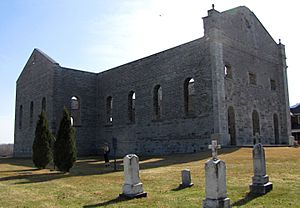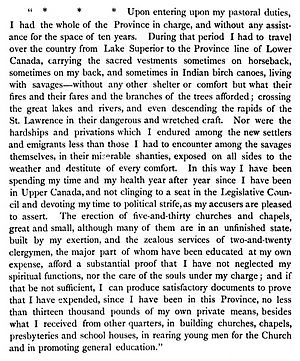Alexander Macdonell (bishop of Kingston) facts for kids
Quick facts for kids Alexander Macdonell |
|
 MacDonell c. 1823 by Martin Archer Shee |
|
| Born | 17 July 1762 in Glen Urquhart, Scotland |
|---|---|
| Died | 14 January 1840 (aged 77) in Dumfries, Scotland |
Bishop Alexander Macdonell was a very important leader and the first Roman Catholic bishop of Kingston, Upper Canada. He was born in Scotland on July 17, 1762, and passed away on January 14, 1840.
He helped many people from Scotland move to Canada. These people were mostly soldiers from a group called the Glengarry Fencibles. When they arrived in Canada, they received land for their service.
When Macdonell came to Canada in 1804, there were only a few priests and churches. Thanks to his hard work, many more people came to the province. By the time he died, there were forty-eight churches and many priests, plus schools and a college.
Contents
Early Life of Alexander Macdonell
Alexander Macdonell was born in Glen Urquhart, Scotland. He studied to become a priest in secret schools because it was against the law at the time. He went to colleges in Paris and Spain. He became a priest on February 16, 1787. When he returned to Scotland, he worked secretly as a priest for five years. People called him Sandaidh Mòr ("Big Sandy") and Maighstir Alisdair ("Father Alistair") in Scottish Gaelic.
Helping the Glengarry Fencibles
In 1792, many people from his area were forced to leave their homes. Even though he was a Catholic priest and considered an outlaw, Macdonell helped them. He convinced business people in Glasgow to hire them. He also acted as their priest and interpreter, as they were Catholic and spoke Scottish Gaelic.
Two years later, many of these Highlanders lost their jobs. The only way to find work was to join the army. However, Catholics were not allowed to join because of certain rules. Father Macdonell suggested that the Highlanders form their own Catholic regiment.
King George III agreed to this idea. In 1794, Father Alexander Macdonell became the first Catholic military chaplain in the British Army since the Reformation. More than half of the 800 soldiers in the regiment were from Glengarry.
The regiment was sent to Ireland in 1798 during a rebellion. They were known for being kind to those they defeated. Father Macdonell helped make sure they acted with humanity. He also helped restore Catholic chapels that had been used for other purposes. He held Mass in these places and encouraged people to return to their homes.
An American bishop said that Father Macdonell "saved the lives of many innocent Irishmen and restored the chapels to their original purpose."
Moving to Canada
When the Glengarry Fencibles regiment was disbanded in 1802, Father Macdonell asked the government to give land to its members in Canada. The government first suggested an island called Trinidad, but Macdonell insisted on Canada. Despite many challenges, he helped his friends move there.
Father Macdonell arrived in York, Upper Canada (now Toronto), on November 1, 1804. He helped the people settle on the land given by the British government. He made St. Raphael's in Glengarry his main base for twenty-five years.
When he arrived, there were only three other priests in the whole province. For ten years, Father Macdonell was in charge of most of the province with very little help. He traveled all over, sometimes on horseback, sometimes in canoes, and sometimes on foot, to serve his community.
In 1812, he helped create another regiment called the Glengarry Light Infantry Fencibles. This group helped defend Upper Canada during the War of 1812. People said he was like a medieval churchman who fought and prayed with equal passion.
St. Raphael's Catholic Church was built around 1821. It was one of the oldest churches in Upper Canada. In 1970, a fire destroyed parts of the church. A smaller church was built next to the ruins in 1973.
Becoming a Bishop
In 1817, Upper Canada became a separate church district. Two years later, Father Macdonell was chosen to be a bishop. He was officially made a bishop on December 31, 1820. King George IV even gave him a beautiful bishop's ring.
Six years later, on February 14, 1826, his church district became a full bishopric. Bishop Macdonell then became the first Bishop of Upper Canada, with his main church in Kingston.
Because he knew the country and its people so well, the government often asked for his advice. On October 12, 1831, he was asked to join the Legislative Council of Upper Canada. After that, he was given the title "Honourable."
He started many churches and schools. In 1839, he founded Regiopolis College. This college offered training for young Catholic men. The original building is now part of the Hotel Dieu Hospital (Kingston, Ontario) in Kingston.
Death and Legacy
Bishop Macdonell passed away from pneumonia on January 14, 1840, in Dumfries, Scotland. He had traveled there to raise money for his college and to discuss plans for more people to move to Canada. He was first buried in Scotland, but his remains were later moved to Kingston Cathedral in Canada on September 26, 1861.
There is a bronze statue of Bishop Macdonell in Toronto.
Honoring Bishop Macdonell
- A special plaque was put up in his memory at St. Raphael's, Alexandria, in 1843. This was done by the Highland Society of Canada, which Macdonell had started.
- The town of Alexandria in North Glengarry, Ontario is named after him.
- In Guelph, Ontario, a Catholic high school was renamed Bishop Macdonell Catholic High School in 1962. A street in Guelph, Macdonell Street, is also named in his honor.
- Macdonell Street in Kingston, Ontario, is named after him.
- His house in Toronto, built in 1832, still stands today. It is now a restaurant and is recognized as a heritage building.
See Also
- Roman Catholic Archdiocese of Kingston



